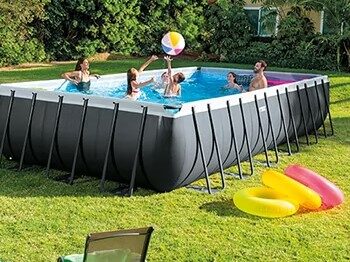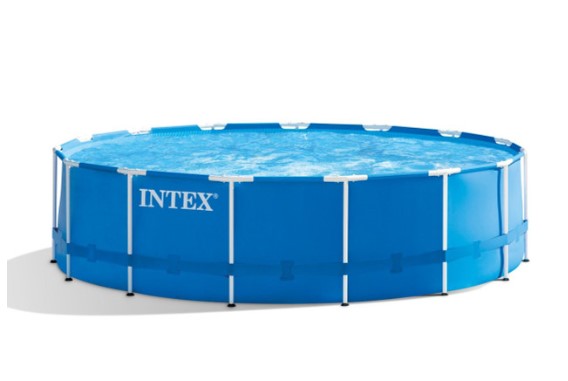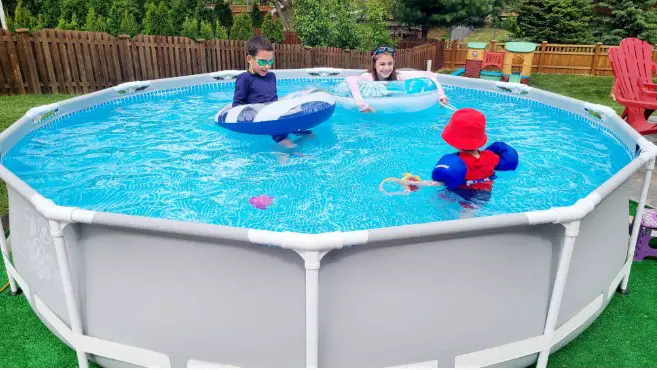Table of Contents
When it comes to maintaining the pristine water quality of a hot tub, one of the most essential tools in the arsenal of a hot tub owner is chlorine tablets.
These small, compact, and easy-to-use tablets offer an efficient way to sanitize the water, ensuring a safe and enjoyable soaking experience for everyone.
Chlorine tablets work by releasing chlorine into the water, which dispels bacteria, algae, and other contaminants that can cause unpleasant odors and irritation for users.
Chlorine tablets for hot tubs come in various sizes and concentrations, allowing for a customized approach to maintaining water quality.
Typically, hot tub owners can choose between slow-dissolving tablets and fast-dissolving tablets, depending on the desired rate of chemical release.
It’s crucial to follow the manufacturer’s guidelines for the specific hot tub in use, as improper dosing may lead to issues such as over-chlorination or inadequate sanitization.
It is important to note that while chlorine tablets offer convenience and effectiveness, they should be used in conjunction with a proper care routine, including regular testing and balancing of water levels.
By doing so, hot tub owners can ensure that their relaxation haven remains a welcoming and healthful oasis for all to enjoy.
What Are Chlorine Tablets?
Chlorine tablets, a common chemical sanitizer used in hot tubs, play an essential role in maintaining water cleanliness and clarity. As a powerful disinfectant, chlorine tablets effectively kill bacteria, algae, and other microorganisms, promoting a healthier and more enjoyable hot tub experience.
These tablets are typically made from a stabilized form of chlorine called trichloroisocyanuric acid (Trichlor), which slowly dissolves and releases sanitizing agents into the water. Thanks to their slow-dissolving properties, chlorine tablets provide a continuous supply of sanitizer to ensure optimal water quality.
Chlorine tablets come in various sizes, such as one-inch and three-inch diameters, to accommodate different hot tub and spa sizes. It’s important to dose chlorine tablets appropriately according to the manufacturer’s instructions, as too much or too little can cause imbalances in water chemistry.
When using chlorine tablets, consider the following factors to ensure a pleasant and safe hot-tubbing experience:
- Storage: Store chlorine tablets in a cool, dry place away from direct sunlight and other chemicals to prevent degradation.
- Handling: Wear gloves when handling chlorine tablets and avoid inhaling the fumes, as they can be irritating.
- Dosing: Follow the manufacturer’s dosage recommendations closely, and use a test kit to accurately measure chlorine levels.
- Filtration and circulation: Maintain proper water circulation and filtration to help disperse the chlorine evenly throughout the hot tub.
By understanding chlorine tablets and their role in maintaining water cleanliness, it becomes easier to provide a safe and enjoyable hot tub experience for everyone.
Types of Chlorine Tablets for Hot Tubs
Trichlor
Trichlor, or trichloroisocyanuric acid, is a popular choice for hot tub sanitization due to its slow-dissolving nature and high chlorine content. It comes in the form of tablets or sticks that are placed in a floating dispenser or a chemical feeder to gradually release chlorine into the hot tub water. Some benefits of using Trichlor include:
- Slow dissolving, providing a consistent level of chlorine
- High chlorine content, requiring fewer tablets
- Stabilized formula, protecting the chlorine from UV degradation
However, Trichlor can add too much stabilizer to the water over time, which may lead to decreased chlorine effectiveness and require more frequent water changes.
Dichlor
Dichlor, or sodium dichloroisocyanurate, is another common choice for hot tub chlorine tablets. Similar to Trichlor, it’s also stabilized and works well for maintaining consistent chlorine levels in the hot tub. Key advantages of Dichlor include:
- Stabilized formula, making it resistant to UV degradation
- Fast dissolving, allowing for quick water treatment
- Less acid, resulting in a lower impact on pH levels
However, Dichlor’s fast-dissolving nature means that more frequent dosages may be needed to maintain proper chlorine levels in the water.
Bromine
Bromine is an alternative to chlorine for hot tub disinfection. It comes in tablet form and can be used in floating dispensers or chemical feeders, just like chlorine tablets. Some notable benefits of using Bromine include:
- Lower odor, making it more pleasant for users
- Less harsh on skin and eyes
- Remains active even at higher temperatures
- Effectiveness in a wider pH range
On the downside, Bromine needs to be added at a more constant rate to maintain proper sanitization levels, and it is less effective in killing algae than chlorine.
Benefits of Using Chlorine Tablets
Chlorine tablets are an effective and popular method to maintain the cleanliness and safety of a hot tub. These small, dissolvable tablets offer several benefits:
Sanitization
Keeping a hot tub sanitary is vital to the health and comfort of its users. Chlorine tablets efficiently kill bacteria, viruses, and algae, ensuring a clean environment for bathers.
pH Balance
A hot tub’s water chemistry is crucial for both its cleanliness and the equipment’s longevity. Chlorine tablets can help maintain a balanced pH level, which is typically between 7.2 and 7.8. This balance fosters a comfortable bathing experience and protects the hot tub’s components from damage due to imbalanced water.
Bacterial Control
Chlorine tablets effectively combat a variety of common bacteria and contaminants. These include:
- Pseudomonas aeruginosa: This bacteria can cause skin rashes and infections in the ears and eyes.
- Escherichia coli (E. coli): This bacteria is often associated with waterborne illnesses, such as gastrointestinal issues.
- Cryptosporidium: This parasite is resistant to chlorine, but with the proper use of chlorine tablets, it can be controlled and prevented from spreading.
By using chlorine tablets for your hot tub, you can help ensure a clean, safe, and enjoyable experience for everyone.
How to Add Chlorine Tablets to Your Hot Tub
Chlorine tablets are an important part of hot tub maintenance, as they help keep the water sanitized and safe for use. In this section, we will discuss how to properly add chlorine tablets to your hot tub.
Step-by-Step Guide
Using chlorine tablets is quite simple, and can be easily incorporated into your routine maintenance. Follow these steps to ensure your hot tub stays clean and fresh:
- Turn off the hot tub and let the water sit undisturbed for a few hours before adding tablets. This helps ensure the water is balanced before adding the chlorine.
- Put on protective gloves and carefully open the package containing the chlorine tablets, making sure not to touch them directly with your hands. Chlorine can cause irritation if touched directly, so always use gloves when handling tablets.
- Place the required number of tablets in a floating dispenser, specifically designed for hot tubs. The amount of chlorine tablets needed depends on the size of your hot tub and the recommended dosing guidelines from the tablet manufacturer.
- Place the floating dispenser in the hot tub, making sure it is floating upright in the water. Allow the tablets to dissolve slowly, releasing the chlorine into the water. This process typically takes several hours to complete.
- Regularly check the chlorine level in the hot tub using test strips or a digital testing device. It is important to maintain the proper chlorine level, which usually falls between 3-5 parts per million (ppm). Adjust the number of tablets used as necessary to reach the desired chlorine concentration.
- Replace the tablets in the dispenser as needed. Be aware that factors such as bather load, water temperature, and sunlight can affect the rate at which chlorine is used up, so monitoring the chlorine level is essential to properly maintaining your hot tub.
By following these steps, you can confidently keep your hot tub clean and comfortable with the use of chlorine tablets.
Maintaining Chlorine Tablet Levels
Properly maintaining chlorine tablet levels in your hot tub is essential for ensuring a safe and clean environment. The two key aspects to consider are testing the water chemistry and adjusting chlorine levels accordingly.
Testing Water Chemistry
Regularly testing your hot tub’s water chemistry is crucial in maintaining ideal chlorine tablet levels. It is recommended to test the water at least once a week using a water test kit or test strips. These tests measure important factors such as chlorine, pH, and alkalinity levels.
For accurate results, follow these steps:
- Fill a small container with water from the hot tub, preferably from a depth of about elbow level.
- Dip the test strip into the container and remove it promptly following the test strip instructions.
- Compare the color on the test strip to the provided color chart to determine the current water chemistry levels.
Adjusting Chlorine Levels
Based on the test results, you may need to adjust the chlorine levels in your hot tub. Here are the common scenarios you may encounter:
| Scenario | Action |
|---|---|
| Chlorine levels are too low | Add more chlorine tablets to the floating dispenser or skimmer. |
| Chlorine levels are too high | Remove some tablets from the dispenser or skimmer and allow the levels to decrease naturally, or consider diluting the water. |
| pH or alkalinity levels are imbalanced | Use appropriate chemicals to adjust the pH or alkalinity levels according to manufacturer recommendations. |
By regularly testing and adjusting the chlorine levels in your hot tub, you can ensure a healthy and enjoyable environment for everyone.
Chlorine Tablets Safety Tips
Storage and Handling
Chlorine tablets should always be stored in a cool, dry, and well-ventilated area. It’s vital to keep them out of direct sunlight as prolonged exposure to heat can cause the tablets to break down or release hazardous gases.
When handling chlorine tablets, it’s recommended to wear protective gloves to avoid skin irritation. Persons with sensitive skin or allergies should exercise extra caution. In addition, make sure to always wash your hands after handling the tablets.
- Store in a cool, dry, and well-ventilated area
- Keep out of direct sunlight
- Wear protective gloves when handling
- Wash hands after handling
Hot Tub Safety
Ensuring the right balance of chemicals in your hot tub helps keep it clean and safe for users. It’s essential to test the water regularly using a testing kit to monitor the chlorine levels.
Maintaining the correct chlorine concentration prevents the growth of bacteria and other microorganisms that can cause skin or respiratory problems.
Floating dispensers are a useful tool for distributing chlorine evenly throughout the water. Make sure to check the dispenser regularly, replenishing the tablets as needed.
Children and pets should be supervised around the hot tub area, particularly when chemicals like chlorine tablets are being used.
If a person experiences any irritation or discomfort while using the hot tub, it’s important to immediately exit the water and consult a medical professional.
| Testing Kit: | Monitor chlorine levels regularly |
| Floating Dispenser: | Ensure even chlorine distribution |
| Supervision: | Watch children and pets around the hot tub |
Key Takeaways
Chlorine tablets play an essential role in maintaining clean and safe water in hot tubs. In this section, we will highlight their importance and provide some key points for maintaining a healthy hot tub environment.
First and foremost, chlorine tablets serve as an effective sanitizer, killing bacteria, algae, and other contaminants in the water. Furthermore, they help in maintaining a balanced pH level and prevent the growth of harmful microorganisms.
- Chlorine tablets should be used regularly and according to the manufacturer’s instructions to ensure proper sanitation and water balance.
- Hot tub owners should routinely check the chlorine and pH levels to make adjustments as needed.
- While using chlorine tablets, it’s crucial to ensure adequate water circulation to distribute the sanitizer evenly.
- Always store chlorine tablets in a cool, dry place away from direct sunlight and other chemicals to prevent contamination.
- Handle chlorine tablets with care, wearing protective gloves to avoid skin irritation and using appropriate tools to avoid spills or splashes.
Bottom line, chlorine tablets are an effective, convenient, and vital aspect of hot tub maintenance. By following these key takeaways and adhering to manufacturer guidelines, hot tub owners can enjoy a clean, safe, and relaxing spa experience.




